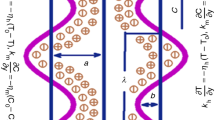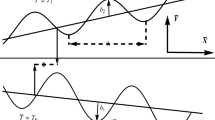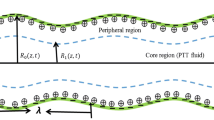Abstract
Heat characteristics of electroosmotic peristaltic flow are investigated in the porous microtube. Flow and heat equations are modeled using the Jeffrey fluid and viscous dissipation, respectively. The wall is patterned with a periodic array of sinusoidal peristaltic waves. In the presence of axial electric field, the chemical interaction of electrolyte (Jeffrey fluid) and the peristaltic walls (solid) cause an electric double layer at the interface. Based on low Reynolds assumption and Debye-Hückel linearization, the Poisson-Boltzmann equation formally solves the potential distribution, and the resulting non-linear problem is numerically solved via the NDSolve built-in scheme of the computing software Mathematica. Expression of interest like electric potential, velocity, pressure gradient, temperature, streamlines, and wall shear stress are executed numerically within the Jeffrey fluid flow pattern. A complete parametric study is executed to find out the outturn of material parameter λ1, permeability of porous medium K, electroosmotic parameter me, mobility of the medium β, and Brinkman number Br on the thermal features of the flow. This model is also suitable for a wide range of biological microfluidic applications. It is observed that the morphology of heat transfer in the flow is found to be subject to the joint consequence of the geometry of the tube and wall properties. The axial velocity increases monotonically for the Jeffrey fluid when equated to the viscous fluid. Moreover, velocity is noticed to upsurge with higher values of electroosmotic parameter and declines for porous medium and mobility of medium. The magnitude of bolus is larger for the case of Newtonian fluid as compared with non-Newtonian Jeffery fluid. Porosity decays the temperature throughout the microtube. The results presented may potentially be applied to clinical cases associated with the intrapleural membranes, gastrointestinal tract, and capillaries.










Similar content being viewed by others
Abbreviations
- a :
-
Tube radius at inlet [L]
- b :
-
Wave amplitude [L]
- B r :
-
Brinkman number
- c :
-
Wave speed [L/T]
- c p :
-
Heat capacity of fluid [ ML2/T2K]
- e :
-
Electron charge [ C]
- E z :
-
Axial electric field [ M/T3A]
- E c :
-
Eckert number
- f :
-
Flow rate [ L3/T]
- K :
-
Permeability parameter
- K B :
-
Boltzmann constant [ML2/T2 K]
- k :
-
Thermal conductivity of fluid [ ML/T3K]
- m e :
-
Electroosmotic parameter
- n ± :
-
Positive, negative ions
- n 0 :
-
Average number of n+ or n− ions
- \( \overset{\sim }{p} \) :
-
Pressure field [ML/T2]
- p :
-
Pressure field
- P r :
-
Prandtl number
- R e :
-
Reynolds number
- S c :
-
Schmidt number
- \( \overset{\sim }{t} \) :
-
Dimensional time [T]
- \( \overset{\sim }{T} \) :
-
Temperature field [K]
- U hs :
-
Helmholtz-Smoluchowski velocity [L/T]
- \( \overset{\sim }{U},\overset{\sim }{W} \) :
-
Dimensional velocity components in stationary frame [L/T]
- \( \overset{\sim }{u},\overset{\sim }{w} \) :
-
Non-dimensional velocity components in wave frame
- \( \overset{\sim }{R},\overset{\sim }{Z} \) :
-
Dimensional coordinates in stationary frame [L]
- \( \overset{\sim }{r},\overset{\sim }{z} \) :
-
Non-dimensional coordinates in wave frame
- z v :
-
Valence of ions
- α :
-
Wave number
- β :
-
Mobility of the medium
- ∈:
-
Permittivity of free space [T4A2/ML3]
- ε :
-
Amplitude ratio
- θ :
-
Temperature field [K]
- λ :
-
Wavelength of peristaltic wave [L]
- λ D :
-
Debye length [L]
- λ 1 :
-
Ratio of relaxation to retardation times
- λ 2 :
-
Retardation time [T]
- ρ :
-
Density of fluid [M/L3]
- ρ e :
-
Net ionic charge density [M/L3]
- ρc p :
-
Heat capacity of the fluid [ML2/T2K]
- \( \overset{\sim }{\Phi} \) :
-
Dimensional electric potential distribution [ML2/T2I]
- Φ:
-
Non-dimensional electric potential distribution
- ψ :
-
Dimensional stream function [L2/T]
References
Tsao, H. K. (2000). Electroosmotic flow through an annulus. Journal of Colloid and Interface Science, 225, 247–250. https://doi.org/10.1006/jcis.1999.6696.
Yang, R. J., Fu, L. M., & Lin, Y. C. (2001). Electroosmotic flow in microchannels. Journal of Colloid and Interface Science, 239, 98–105. https://doi.org/10.1006/jcis.2001.7551.
Fu, L. M., Lin, J. Y., & Yang, R. J. (2003). Analysis of electroosmotic flow with step change in zeta potential. Journal of Colloid and Interface Science, 258, 266–275.
Qiao, R. A. N. A., & Aluru, N. R. (2002). A compact model for electroosmotic flows in microfluidic devices. Journal of Micromechanics and Microengineering, 12, 625. https://doi.org/10.1088/0960-1317/12/5/318.
Glasgow, I., Batton, J., & Aubry, N. (2004). Electroosmotic mixing in microchannels. Lab on a Chip, 4, 558–562. https://doi.org/10.1039/B408875A.
Akermi, M., Jaballah, N., Alarifi, I. M., Rahimi-Gorji, M., Chaabane, R. B., Ouada, H. B., & Majdoub, M. (2019). Synthesis and characterization of a novel hydride polymer P-DSBT/ZnO nanocomposite for optoelectronic applications. Journal of Molecular Liquids, 287, 110963. https://doi.org/10.1016/j.molliq.2019.110963.
Kahshan, M., Lu, D., & Rahimi-Gorji, M. (2019). Hydrodynamical study of flow in a permeable channel: Application to flat plate dialyzer. International Journal of Hydrogen Energy, 44, 17041–17047. https://doi.org/10.1016/j.ijhydene.2019.04.211.
Uddin, S., Mohamad, M., Rahimi-Gorji, M., Roslan, R., & Alarifi, I. M. (2020). Fractional electro-magneto transport of blood modeled with magnetic particles in cylindrical tube without singular kernel. Microsystem Technologies, 26, 405–414. https://doi.org/10.1007/s00542-019-04494-0.
Kasaragadda, S., Alarifi, I. M., Rahimi-Gorji, M., & Asmatulu, R. (2020). Investigating the effects of surface superhydrophobicity on moisture ingression of nanofiber-reinforced bio-composite structures. Microsystem Technologies, 26, 447–459. https://doi.org/10.1007/s00542-019-04507-y.
Reddy, M. G., & Makinde, O. D. (2016). Magnetohydrodynamic peristaltic transport of Jeffrey nanofluid in an asymmetric channel. Journal of Molecular Liquids, 223, 1242–1248. https://doi.org/10.1016/j.molliq.2016.09.080.
Fusi, L., & Farina, A. (2017). Peristaltic flow of a Bingham fluid in a channel. Int J Non-Linear Mech, 97, 78–88. https://doi.org/10.1016/j.ijnonlinmec.2017.09.003.
Ebaid, A., Aly, E. H., & Vajravelu, K. (2017). Analytical solution for peristaltic transport of viscous nanofluid in an asymmetric channel with full slip and convective conditions. Communications in Theoretical Physics, 68, 96. https://doi.org/10.1088/0253-6102/68/1/96.
Latha, R., Kumar, B. R., & Makinde, O. D. (2018). Effects of heat dissipation on the peristaltic flow of Jeffery and Newtonian fluid through an asymmetric channel with porous medium. Defect Diffusion Forum, 387, 218–243. https://doi.org/10.4028/www.scientific.net/DDF.387.218.
Bég, O. A., Ghosh, S. K., & Narahari, M. (2019). Mathematical modelling of oscillatory MHD Couette flow in a rotating highly permeable medium permeated by an oblique magnetic field. Chemical Engineering Communications, 198, 235–254. https://doi.org/10.1080/00986445.2010.500165.
Das, S., & Chakraborty, S. (2006). Analytical solutions for velocity, temperature and concentration distribution in electroosmotic microchannel flows of a non-Newtonian bio-fluid. Analytica Chimica Acta, 559, 15–24. https://doi.org/10.1016/j.aca.2005.11.046.
Chakraborty, S. (2007). Electroosmotically driven capillary transport of typical non-Newtonian biofluids in rectangular microchannels. Analytica Chimica Acta, 605, 175–184. https://doi.org/10.1016/j.aca.2007.10.049.
Srinivas, S., & Muthuraj, R. (2010). Peristaltic transport of a Jeffrey fluid under the effect of slip in an inclined asymmetric channel. International Journal of Applied Mechanics, 2, 437–455. https://doi.org/10.1142/S1758825110000573.
Tripathi, D., Ali, N., Hayat, T., Chaube, M. K., & Hendi, A. A. (2011). Peristaltic flow of MHD Jeffrey fluid through finite length cylindrical tube. Appli Math Mech, 32, 1231. https://doi.org/10.1007/s10483-011-1496-7.
Abd-Alla, A. M., & Abo-Dahab, S. M. (2015). Magnetic field and rotation effects on peristaltic transport of a Jeffrey fluid in an asymmetric channel. Journal of Magnetism and Magnetic Materials, 374, 680–689. https://doi.org/10.1016/j.jmmm.2014.08.091.
Chakraborty, S. (2006). Augmentation of peristaltic microflows through electro-osmotic mechanisms. Journal of Physics D: Applied Physics, 39, 5356. https://doi.org/10.1088/0022-3727/39/24/037.
Bandopadhyay, A., Tripathi, D., & Chakraborty, S. (2016). Electroosmosis-modulated peristaltic transport in microfluidic channels. Physics of Fluids, 28, 052002. https://doi.org/10.1063/1.4947115.
Yadav, A., Bhushan, S., & Tripathi, D. (2018). Peristaltic pumping through porous medium in presence of electric double layer. EDP Sci, 92, 02043. https://doi.org/10.1051/matecconf/201819202043.
Noreen, S., Waheed, S., & Hussanan, A. (2019). Peristaltic motion of MHD nanofluid in an asymmetric micro-channel with joule heating, wall flexibility and different zeta potential. Boundary Value Problems, 2019, 12. https://doi.org/10.1186/s13661-019-1118-z.
Noreen, S., & Tripathi, D. (2019). Heat transfer analysis on electroosmotic flow via peristaltic pumping in non-Darcy porous medium. Therm Sci Eng Pro, 11, 254–262. https://doi.org/10.1016/j.tsep.2019.03.015.
Noreen, S., Waheed, S., & Lu, D. C. (2020). Influence of joule heating and wall slip in electroosmotic flow via peristalsis: Second law analysis. J Brazilian Soc Mech Sci Eng, 42, 295. https://doi.org/10.1007/s40430-020-02351-0.
Noreen, S., Waheed, S., & Lu, D. C. (2020). Electrothermal transport via copper nanoparticles in a microchannel propagated by peristalsis. SN Appl Sci, 2, 1–15. https://doi.org/10.1007/s42452-020-03324-7.
Misra, J. C., Chandra, S., Shit, G. C., & Kundu, P. K. (2014). Electroosmotic oscillatory flow of micropolar fluid in microchannels: Application to dynamics of blood flow in microfluidic devices. Applied Mathematics and Mechanics, 35, 749–766. https://doi.org/10.1007/s10483-014-1827-6.
Tripathi, D., Yadav, A., & Bég, O. A. (2017). Electro-osmotic flow of couple stress fluids in a micro-channel propagated by peristalsis. Eur Phys J Plus, 132, 173. https://doi.org/10.1140/epjp/i2017-11416-x.
Prakash, J., & Tripathi, D. (2018). Electroosmotic flow of Williamson ionic nanoliquids in a tapered microfluidic channel in presence of thermal radiation and peristalsis. Journal of Molecular Liquids, 256, 352–371. https://doi.org/10.1016/j.molliq.2018.02.043.
Tripathi, D., Yadav, A., Bég, O. A., & Kumar, R. (2018). Study of microvascular non-Newtonian blood flow modulated by electroosmosis. Microvascular Research, 117, 28–36. https://doi.org/10.1016/j.mvr.2018.01.001.
Waheed, S., Noreen, S., & Hussanan, A. (2019). Study of heat and mass transfer in electroosmotic flow of third order fluid through peristaltic microchannels. Applied Sciences, 9, 2164. https://doi.org/10.3390/app9102164.
Jayavel, P., Jhorar, R., Tripathi, D., & Azese, M. N. (2019). Electroosmotic flow of pseudoplastic nanoliquids via peristaltic pumping. Journal of the Brazilian Society of Mechanical Sciences and Engineering, 41, 61. https://doi.org/10.1007/s40430-018-1555-0.
Ramesh, K., & Prakash, J. (2019). Thermal analysis for heat transfer enhancement in electroosmosis-modulated peristaltic transport of Sutterby nanofluids in a microfluidic vessel. Journal of Thermal Analysis and Calorimetry, 138, 1311–1326. https://doi.org/10.1007/s10973-018-7939-7.
Ramesh, K., Tripathi, D., Bhatti, M. M., & Khalique, C. M. (2020). Electro-osmotic flow of hydromagnetic dusty viscoelastic fluids in a microchannel propagated by peristalsis. Journal of Molecular Liquids, 314, 113568. https://doi.org/10.1016/j.molliq.2020.113568.
Author information
Authors and Affiliations
Corresponding author
Ethics declarations
Conflict of Interest
The authors declare that they have no conflict of interest.
Research Involving Humans and Animals Statement
None.
Informed Consent
None.
Additional information
Publisher’s Note
Springer Nature remains neutral with regard to jurisdictional claims in published maps and institutional affiliations.
Highlights
Electroosmotically assisted peristaltic flow of the Jeffery fluid through microtube is studied.
Thermal analysis and porosity through peristaltically induced microtube, with applied electric field is also investigated.
The axial velocity increases monotonically for the Jeffery fluid as compared with the Newtonian fluid.
Temperature distribution strongly depends on electroosmotic parameter.
Porosity effect causes the enhancement of wall shear stress.
This analysis is useful in biomedical research.
Rights and permissions
About this article
Cite this article
Noreen, S., Waheed, S. Study of Heat Characteristics of Electroosmotic Mediator and Peristaltic Mechanism via Porous Microtube. BioNanoSci. 11, 476–488 (2021). https://doi.org/10.1007/s12668-020-00815-0
Accepted:
Published:
Issue Date:
DOI: https://doi.org/10.1007/s12668-020-00815-0




